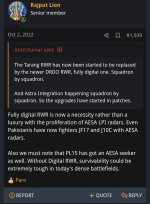I wanted to say more but this comes as a surprise.
"...Operations are still ongoing..."
My guess is, they remain in a heightened alert state and ISR assets are still at work to check for more possible ceasefire violations after India retaliated with drone strikes for last night's CFV.
====
Anyway, just to get our thoughts in order as we begin the phase of analyzing how the air operations unfolded, I think one of the aspects that we need to pay particular attention to is the
use of AESA-based seekers on the PL-15s, and how they must have affected the equation with SPECTRA's ability to jam/spoof incoming active-guidance threats.
We know that evading AIM-120C-5s with regular pulse-doppler seekers was not a problem for our aircraft even back in 2019, thanks in part to externally carried jammers like EL/L-8222. The internally carried SPECTRA suite was meant to provide a similar capability to the Rafale - but the advent of AESA seekers make matters complicated, as I had previously predicted:
So the information we want keeps coming in. https://www.eurasiantimes.com/hold-scrapping-mmrca-was-a-blunder-india/ “MMRCA should have gone through. It was a blunder not going for it. It would have brought world-class manufacturing facilities to India and skill development. The French were...

www.strategicfront.org
"...But even that will become difficult as missiles with 60+ TRM AESA seekers will become commonplace in the next decade. Unlike FCRs where the TRMs have to conduct multiple roles, an AAM seeker has only one job: maintain lock on the target no matter what. So they will be tailored with ECCMs of such frequency-agility that it becomes impossible to spoof them with a smaller transmitter with fewer TRMs (meaning less frequency-agility of your own, even if you somehow figure out their algorithm).
At that point, a lot of current-gen integrated SPJs (including Rafale's emitters) will become obsolete and aircraft that rely on them for self-protection will no longer be considered survivable as frontline fighters unless flying inside the bubble of a podded escort jammer. The key will be to evade detection entirely and obtain look-first/shoot-first so that the problem of dealing with these next-gen AAMs is for the enemy to figure out..."
Admittedly, at the time I was writing that, I had no idea that the PL-15 already had an AESA seeker. I thought the Chinese were yet to operationalize that technology. So I was off the mark on that part - they won't become a problem next decade, they've already become a problem NOW.
Now we need to see how this informs IAF decisions going forward. First, let's see what they disclose after winding up the operation.



 .....Chinese AWACS performance is sub par according to Porkee themselves..... Astra Mk2 & Gandiva is on a completely different league all together
.....Chinese AWACS performance is sub par according to Porkee themselves..... Astra Mk2 & Gandiva is on a completely different league all together 

